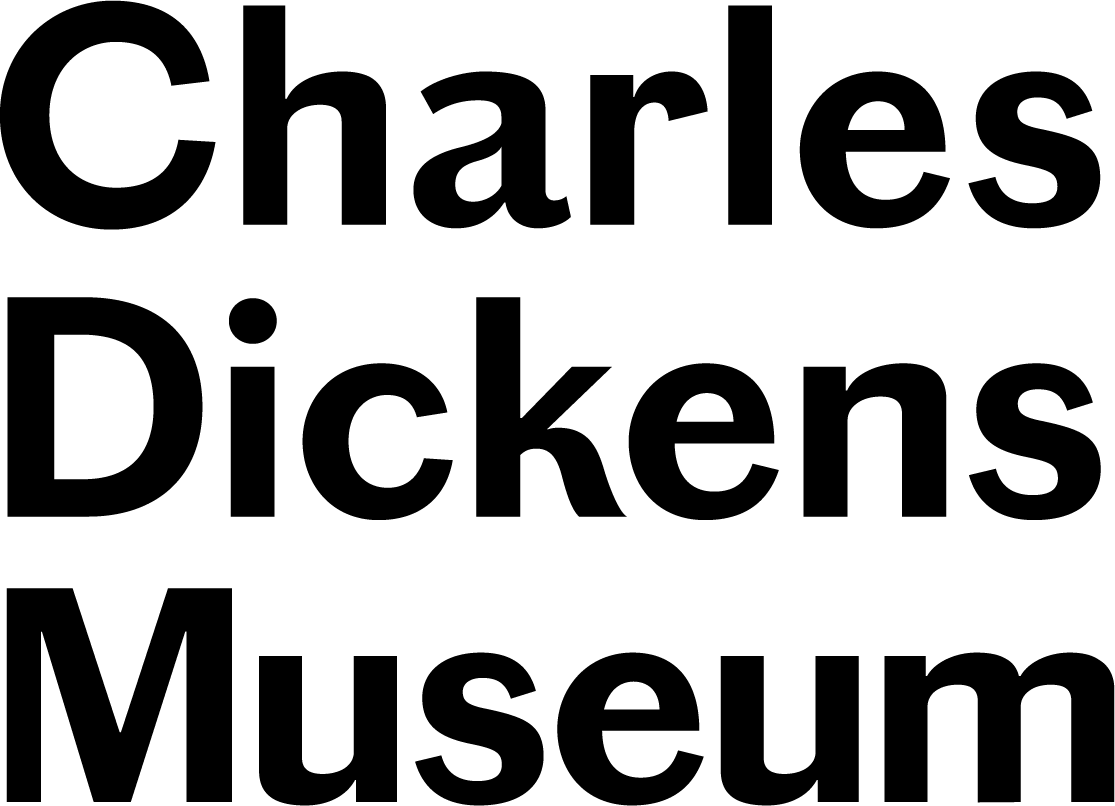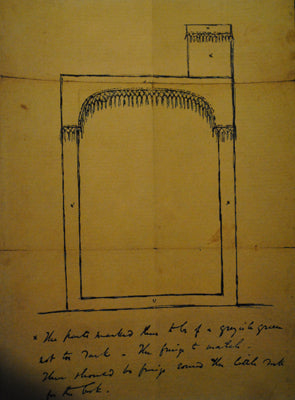The Reading Desk: More than First Meets the Eye
Morgan Leeson is a summer intern at the Charles Dickens Museum and a sophomore studying English at Bates College, located in Lewiston, Maine, U.S.A.
By Morgan Leeson
As part of my new position, as a summer intern, I have been asked to choose six items in the museum to research and blog about each week. For my first item, I’ve decided to explore the history of Charles Dickens’s reading desk, a stately-looking piece that accompanied Dickens on his 1868 reading tour in America. I was initially drawn to the item because of my interest in the reading tours themselves, made famous, in their own right, thanks to Dickens’s powerful performances. However, as I began my research, I was happy to discover the desk was more than an entryway for discussion of the reading tours; rather, I realized that the desk has a story of its own.
One of the oldest residents of 48 Doughty Street, the red-trimmed reading desk has been part of the Charles Dickens Museum’s collection since 1927. Given as a gift by Charles to his second oldest daughter Kate Perugini on the night of his last reading, the desk was later passed down to B.W. Matz, founder of the Dickens Fellowship, before it was gifted to our collection.
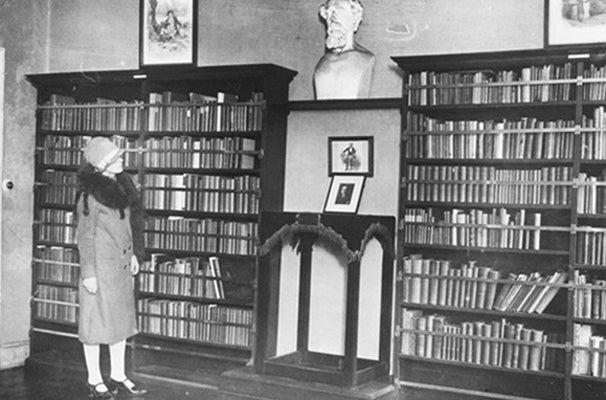
Circa 1927 photograph of the reading desk on display in the then recently opened Charles Dickens Museum. Charles Dickens Museum.
But what, apart from its storied history with the museum, makes this desk so special? Distinct from any podium or lectern, Dickens had this reading desk specially crafted to fit his needs on stage. First among these alterations was Dickens's request that the desk be constructed as an open box, without side walls obstructing the audience’s full view of the speaker. This innovation would have been necessary for one of Dickens’s live readings, as he relied heavily on full-body gestures and movement in order to bring his beloved characters to life.
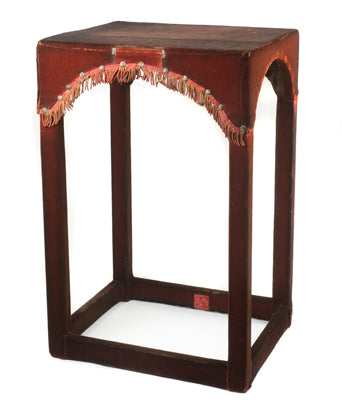
The reading desk, wrapped in crimson fabric and adorned with tasselled arches, is currently on display in the museum’s drawing room. Charles Dickens Museum collection, DH300
Additionally, Dickens adapted the usual lectern design by requesting a box be built atop the podium. This change was made so that Dickens would have a place to rest his arm during what were usually two-hour readings, as he dramatized from a special reader’s copy of his text. These reader’s copies, many of which are housed at the museum today, were re-printings of the passages intended for performance, with extra space left in the margins for Dickens to jot down changes to the text or additional stage directions. 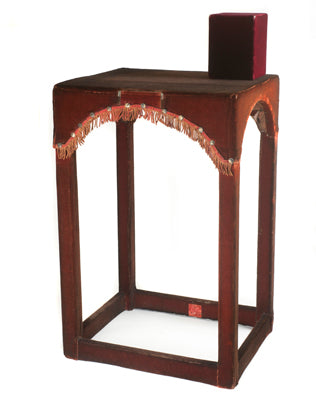
The detachable table-top box, shown above, was utilised as an arm rest during readings. Charles Dickens Museum collection, DH300
Furthermore, in other editions of the desk, Dickens added a shelf off to the right side where he could set necessities, such as a glass of water or a handkerchief. Although no shelf appears attached to the museum’s own reading desk, a record of one such shelf can be seen in a painting completed by Robert Hannah, which is currently on display in the museum’s drawing room.
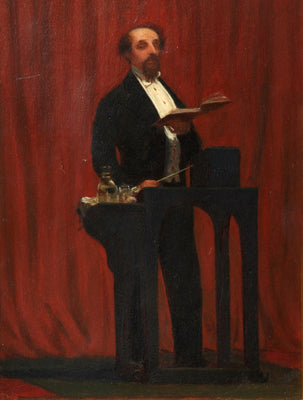
Robert Hannah’s 1858 oil painting of Charles Dickens performing a public reading. Charles Dickens Museum collection, DH309
In addition to tweaking elements of the reading desk’s function, Dickens also made specific changes to the reading desk’s appearance. In a sketch of an earlier desk’s design, Dickens scrawled a small note beneath his drawing, which reads: “The parts marked thus to be of a greyish green, not too dark. The fringe to match. There should be a fringe round the little desk for the book.” Dickens’s note, articulating his desire for a particular shade of green, demonstrates his meticulous attention to detail, as well as his notoriously flamboyant taste in fashion. Later on in his reading career, Dickens would go on to change the fabric colour from green to scarlet, which was known to be his favourite colour.
Charles Dickens’s blue ink design for a reading desk, including a directional note, left at the bottom. Charles Dickens Museum collection, DH311
In an article published in the Dickensian in the winter of 1978, scholar Philip Collins notes that the new scarlet reading desk, created for Dickens’s American reading tour, was part of a larger change in staging. Previously, the green fabric on the desk was accompanied by a matching green carpet, as well as a background consisting of a “well chosen brown.” With the introduction of the red desk, however, Dickens opted for a background draped in swathes of crimson fabric, which he describes in a letter to a friend, Annie Field, as looking: “like the ‘wings’ of a theatre.” Dickens goes on in the letter to note that: “consequently, the figure is now completely isolated, and the slightest action becomes more important.”
With this letter, Dickens gives us a brief glimpse into how he might have conceived of himself as an actor on stage, as well as an author on tour. This dual understanding is unsurprising given Dickens’s long history with theatre; however, perhaps it was this actor’s mentality that led Dickens to take a keen interest in the design of everyday items, as elements such as the reading desk or the background drapes became comparable to props on a set.
Most information gathered from Philip Collins’ article, ‘Dickens’s Public Readings: The Kit and the Team’ in the 1978 Winter Dickensian: 8-16.
Museum Blog
This blog takes you behind the scenes at the Charles Dickens Museum, giving fresh insight on everything from discoveries new and old in our collection, to exhibitions, events and learning initiatives.
You’ll be hearing from a variety of Museum staff and volunteers, as well as guest curators, academics, artists and Dickens enthusiasts. Why not join the debate and let us know you thoughts on the latest blog by using our hashtag #CDMBlog

